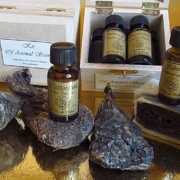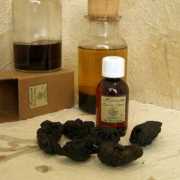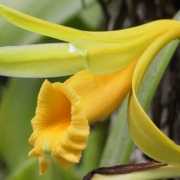Tri-dimensional and Spiritual Perfumes
By AbdesSalaam Attar on Basenotes
It is a mystery why modern men and women, so obsessed with erasing their own bodily smells, are nevertheless so attracted to the animal scents in perfumes that they will consistently prefer fragrances containing “animalic” ingredients to those made of pure botanical ingredients.
In times when these rare materials were still used in commercial perfumes, the purpose was, first of all, to get fragrances sold, and it worked so well that they were deemed indispensable in fine perfumery. Today, the use of animal scents is a very hard path to tread, because of prohibitively high prices, the difficulty of sourcing the materials and ethical dilemmas.
Apart from a few “politically incorrect” indie natural perfumers, the use of real animal ingredients has been abandoned. An interesting exception has been a French nose who rediscovered a strange south African animal raw material, Hyraceum.
Do you want to have “Dassie piss” (Hyraceum indigenous name) in your perfume? Buy the latest work by Duchaufour. Though I suspect that the very idea of spraying oneself with urine has as much to do with the success of the fragrance as the smell of the perfume itself. People think, “Yes, it is piss, but it is from Duchaufour. How chic. I can’t wait to try it…”
Still, our innate attraction to animal scents has deeper origins than the temptations of extreme scatological experiences: the origin is in our genes.
Why do we need animal scent
Have you ever wondered why we like to have green plants and flowers in our homes? The reason is that their presence is necessary for our psychological and emotional balance. And the perfumes of aromatic plants can bring that presence into our lives even in the absence of the plants themselves because perfumes are the singing voice of plants, their inner spirit.
The presence of animals around us is as necessary to our equilibrium as is the presence of plants. Whoever of us can afford it, does keep a pet at home, be it a dog, a cat, a bird, a mouse, a snake, a fish or a tortoise… watching animals, touching them and speaking to them is a need for us. Mankind has lived with domestic animals since its origins. The need for this relation is in our genes.
Have you noticed that children innately love the company of animals? This is because children are nearer to their innate nature than adults are. After all, many of us adults have acquired a pet only to please the desire of a child.
Just as with trees and flowers, the scents of animals can be a substitute for their presence even when we do not live among them, as most of us, in our modern, urban environment, do not. We have constructed lives cut off from the natural world; perfume is a way to restore the harmony we’re missing.
Our present search for scents, then, represents a new step in the history of mankind; it is a search for inner balance, for a message of beauty, expressed in the language of smells, and then translated into positive emotions. It is in this context that the use of animal scents can be understood; as a “perfume-therapy” – much as you would take vitamins if your diet was lacking them.
What are animal scents?
The animal scents traditionally used in perfumery, such as Castoreum, Civet, Hyraceum or Ambergris, are simply pheromones.
Pheromones are the “mother of all scents”. They have been devised by nature to be the first language of communication for living organisms, through their first developed perception organ, the chemical sense, which, for most creatures is the sense of smell.
Studying pheromones is fascinating, because it explains to us what we have in common with animals, and in doing so teaches us, too, of how we differ from them. It reveals to us that our humanity starts with our intellect, and that, unlike animals, we smell more with our brain than with our nose.
Understood more deeply and broadly, the scents of plants are botanical pheromone, they are the medium of communication and attraction between plants and insects, between plants and vertebrates, and even between plants and other plants, in a secret and mysterious way.
This explains why so many of them produce aromas whose molecules mimic animal and sometimes human pheromones: Cumin, for example, along with Sandalwood, Black Currant buds, Buchu, Vanilla, Cinnamon, Calamus, Iris root, Styrax, Clary sage, and many others.
When you know that pheromones are fundamental in the reproduction processes of all living species, you begin to have respect for them, to understand why we are so attracted to them, and of course to imagine what they can do to perfumes.
The power of their effect on us is also shown by the fact that long before they were used in perfumes, animal pheromones were used as medicines. In fact, they are present in all the traditional pharmacopoeias.
Animal scents in Perfumes “tridimensional” perfumery
Most of us have come across one of those marvellous stereoscopic devices, the “View-Master“, through which one peers at two images taken from a slightly different angle. The result is a wonderful 3D image of Venice, Rome or another exotic place.
In much the same way, a fragrance with a small amount of animal scent is generally preferred by most people, because it creates an emotional dimension beyond that of a purely botanical one.
A fragrance made entirely of ingredients from plants meets only a part of our soul’s needs. Animal smells are the other, equally important part of our genetic olfactory memories. They are archetypes of considerable importance in the language of odours. A perfumer is but a storyteller who writes with smells: imagine how few tales or fables could be written without the presence of animals.
This is why I call a perfume that contains both botanical and animal ingredients a three-dimensional perfume; for while there are only two images, they combine, just as the pictures in the stereoscope do, to create an extra emotional dimension. Without them both, the picture may be flat, the story may be too simplistic.
Substitutes for real animal scents, synthetic or obtained from plants such as ambrox or ambrette, may recall or imitate the “tridimensionality” – but then, so do regular photographs, but they are not as “real” as the vision of the “stereoscope”.
We love to live among flowers and trees, we need their presence so much that we bring them into our houses when they are absent in our streets. We do the same with pets. The lack of vegetal and of animal presence that is characteristic of modern city life is very new and unique to the story of mankind. This makes our need for a “three-dimensional” botanical and animal perfume all the more necessary to us.
Spirituality of perfume and animal scents
I learned in the East that perfume means spirituality and that love of perfumes springs from a quality of the soul. Oriental perfumery is an emanation of Eastern spirituality, a marriage between sacred and profane. In the spiritualities of the East, the physical and the spiritual, the sacred and the profane, are not conflicting as they are in our culture, but are rather complementary.
Perfume being part of spirituality in the East, oriental perfumery assumes the colour of oriental spirituality, blending delicate flowers with austere resins, grounded on a base of animal scents.
In all religions, perfume has a privileged place. In Jewish mysticism, for example, all senses give pleasure to the body, except the sense of smell that gives pleasure to the soul. But we should acknowledge that our western perfumery and the modern history of perfume started with the advent of Islam, when the use of perfume was taken away from the priests, healers and noblemen, and was enjoined upon every single person as a religious obligation and personal purification.
The encounter of Islam and Christianity in the medieval epoch brought the use of perfumes to the west.
The widespread use of animal scents in pre-chemical western perfumery is simply expressing the attraction and fascination that Eastern mystics have always exerted on us Western people. It writes the story of our thirst for a Unitarian spirituality that reconciles our humanity with our animality.
This is where animal scents fit in today’s natural perfumery, the essential message of a spiritual harmony that we crave.
To read more of AbdesSalaam Attar’s writings on animal extracts in perfumery, please visit:
ANIMAL SCENTS AND PHEROMONES BY ABDESSALAAM ATTAR
- MuskDeer
- Muskdeer – The scent of the Hereafter
- Amber and Ambergris
- Amber and Ambergris 2
- Report on Kashmiri muskdeer by AbdesSalaam Attar
- Animal Pheromones
- Human sweat, the last frontier of perfumery
- Perfumer’s perversions
- Spirituality of perfume
- Hyraceum, tincturing a 10 000 years old pheromone
- GOAT HAIR TINCTURE AND HUMAN PHEROMONES
- Thoughts from Timbuktu – fixatives
- ANIMAL SCENTS GROUP PROJECTS ON BASENOTES
- Correcting commercial fragrances with hyraceum (2)
- FIRST GAME: Can perfumery pheromones change the longevity and volume of perfumes?
- SECOND GAME: Can pheromones influence our social life, mating choice & impact on the opposite gender
- THIRD GAME: do perfumery pheromones influence the behaviour of others towards us?
- Civet and Mitsuko























Leave a Reply
Want to join the discussion?Feel free to contribute!